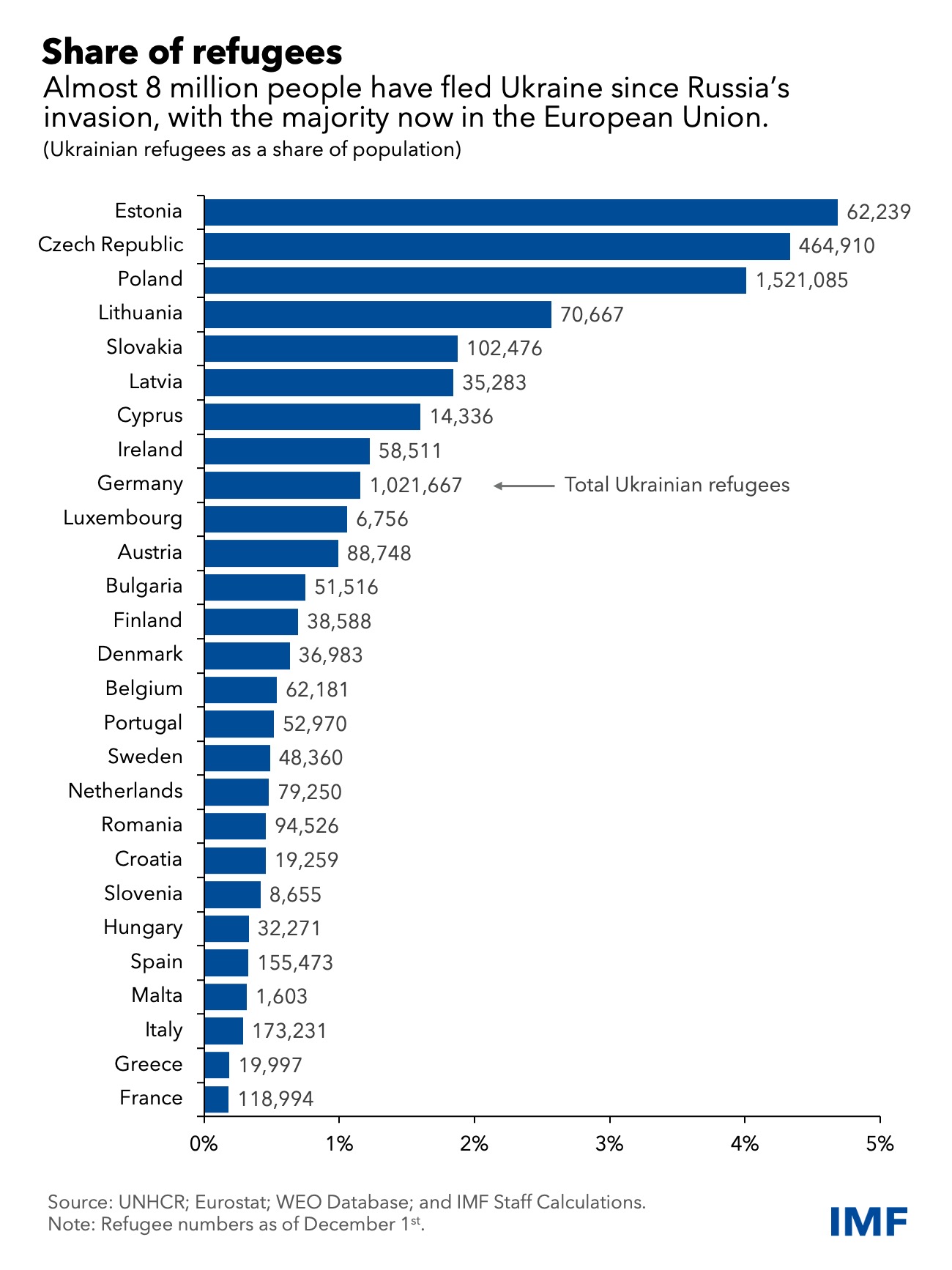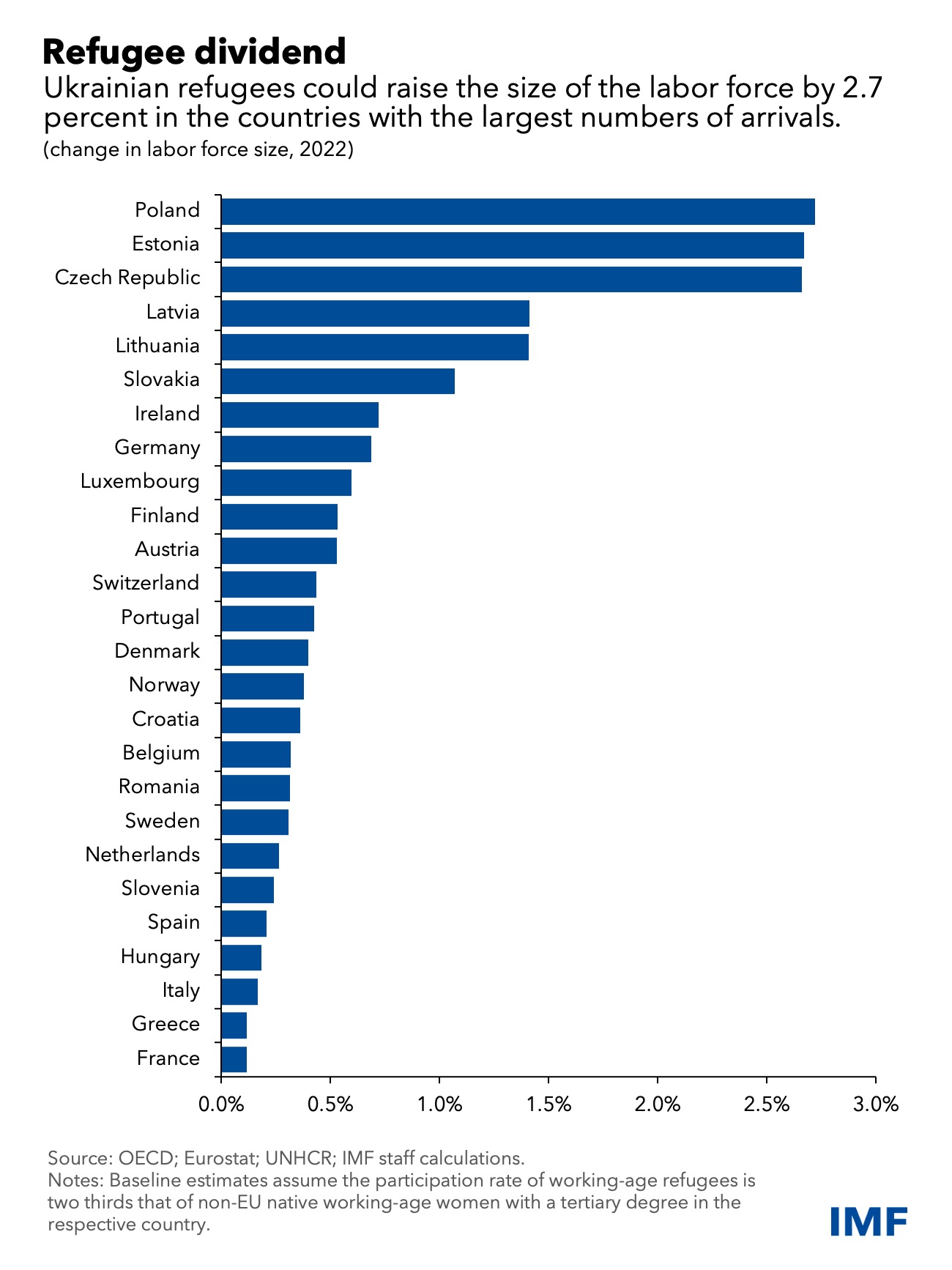Almost 8 million refugees have fled Ukraine since Russia’s invasion in February, Europe’s largest refugee wave since World War II, with the majority of those now in the European Union. These figures will increase depending on the war’s duration and severity.
Creating conditions in which refugees can return home once war ends and reconstruction starts is the overarching objective. However, refugees may stay in their adopted homelands for some time. With the right policies in place, this could be positive for host countries, not least because of labor shortages and aging populations.
Many of those who have fled have a different demographic profile than those in past refugee waves, with surveys in Germany, Moldova and Poland showing that most arrivals are children and women under 40.
Europe reacted with swift and decisive support, and 4.8 million people from Ukraine are registered for temporary protection in the EU or in similar national programs. The EU has removed many barriers refugees typically face by offering residency rights, work permits, and access to health care, schools, housing and banking services.
The bloc is also providing financing to support refugees from Ukraine in the most affected member states, including Moldova and some other countries, and has modified regulations to make it simpler to reorientate some of its existing funds.

Supporting refugees comes with some short-term fiscal costs. Across the EU, these could reach 30 billion euros to 37 billion euros in the first year, or about 0.2 percent of gross domestic product, as we noted in our latest Regional Economic Outlook, published in October. Countries with the largest shares of refugees, including the Czech Republic, Estonia, Moldova, and Poland, could incur fiscal costs this year equal to about 1 percent of GDP. The larger share of women and children will result in more spending on childcare, education, and health care services.
Over the medium term, however, refugees could boost economic growth and tax revenue while helping ease current labor market tightness in some parts of Europe. We estimate that Ukrainian refugees could raise the size of Europe’s labor force by some 0.6 percent by the end of 2022, and by 2.7 percent in the countries with the largest numbers of arrivals, where Ukrainian refugees will ease labor shortages.
Any increase in unemployment because of this surge in labor is likely to be temporary and early signs of refugees’ integration into European labor markets are promising. There is evidence that refugees in Poland and the United Kingdom have found jobs relatively quickly, for example.

How the new refugees affect economic growth in coming years will depend primarily on the speed and quality of their labor market integration, particularly on whether they end up in low-paid jobs that do not match their qualifications or skills. This concern that skills could be downgraded is a risk given that Ukrainian refugees tend to be well educated. At least half of working-age women have completed tertiary education and this share is even higher in some countries, rising to about three-quarters in Germany.
Beyond addressing the war’s terrible economic and social impact in Ukraine itself, Europe can do more to help integrate refugees into its societies and economies. This will help host economies and prepare refugees for a successful eventual return. It might also offer lessons on how to integrate refugees from other corners of the world who may not have the same skills as those from Ukraine but who can nonetheless contribute positively to growth.
-
Active labor market policies, which so far have been used to
varying degrees, could become more tailored to enhance refugees’ skills and
labor market success. These include, for example, the recognition of
qualifications, language training, and job search and matching services.
- Affordable care services are also key to enabling Ukrainian
women to fully participate in host country labor markets.
- Central governments will need to adequately fund local governments, which typically administer programs not only in active labor market policies, but also in education, healthcare, social welfare, and housing, all of which will need continued support.
The need to further support Ukrainian refugees comes at a testing time for Europe, as countries battle with rising energy and food prices and sharply slowing economic growth. Yet it is important to continue the strong solidarity that has allowed Europe to respond so effectively to the refugee crisis so far. Policies that help refugees to integrate economically will help Europe as well as those fleeing Ukraine.




